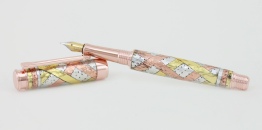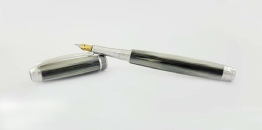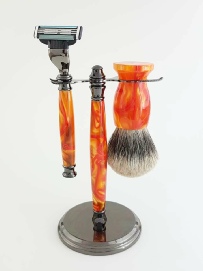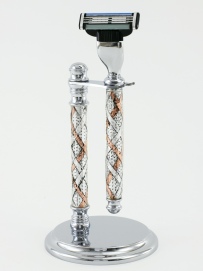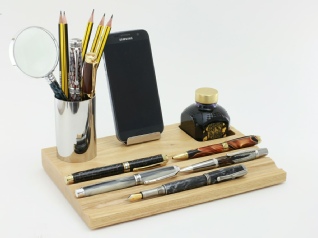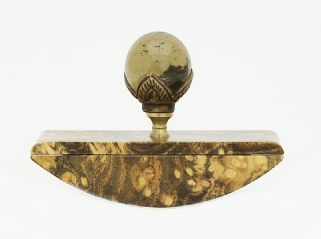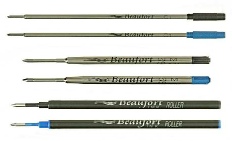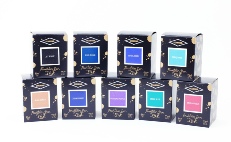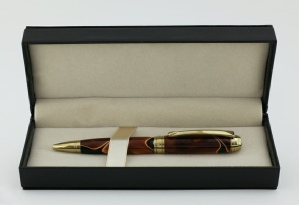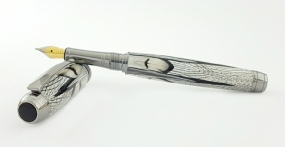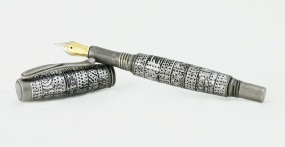


Pens Shaving Desk Accessories Refills Pen Accessories Interest New Arrivals










Handmade Pens and Gifts

Corian is the brand name for a solid surface material created and manufactured by Du Pont an American chemical company.
Du Pont was founded in 1802 as a gunpowder mill by Frenchman Éleuthère Du Pont. In the 20th century, Du Pont has developed many polymers such as neoprene, nylon, Corian, Teflon, Mylar, Kevlar, and Lycra.
Corian’s primary use is kitchen worktops, although it has many other applications. It is composed of an acrylic polymer and alumina trihydrate (ATH), a material derived from bauxite ore.
Corian is the original material of this type, created by Du Pont scientists in 1967.
Corian is manufactured in three thicknesses: 6 mm , 12 mm , and 19 mm .Most of our pens are made from 12mm corian. We do have some made from 19mm but the material is quite rare.
The Corian we use to make our pens comes from the, hob and sink cut outs and off cut waste generated by fabricators, and so save it from becoming landfill.
Caesin plastics were introduced at the end of the 19th and beginning of the 20th century.
The starting material for this remarkable plastic is the protein found in cow’s milk.
It is a plastic manufactured from renewable resources.
The material is capable of taking surface dyes very readily and this quality makes it desirable to be used for the manufacture of clothing buttons and buckles, and so make a huge range of differently coloured products, relatively easily.
Caesin has been described as the most beautiful of plastics, and was produced in a wide variety of colours including delicate pastel shades, pearls and mottles, especially those imitating tortoiseshell and horn.
As well as buttons and buckles, casein was also used for knitting pins, fountain pen and propelling pencil barrels, dressing table ware and a host of other items.
The well known British plastics company Erinoid had its origins in the manufacture of caesin, sometimes known as galalith, from the Greek Gala (milk) and lithos (stone)
Erinoid remained the major producer of casein plastics in the UK until they stopped manufacture in about 1980. At that time they were part of BP.
Caesin/galalith can make remarkably real looking gemstones. Galalith was used to make much of the iconic Art Deco jewellery.
In 1913, 30 million litres of milk were used to make Caesin/ Galalith in Germany alone, globally the demand was huge, and this continued up to the 2nd world war, when the priority for milk consumption was as a food stuff.
As with a lot of things the war changed the production of caesin, with the advent and exploitation of oil based plastics.
However, limited quantities of casein plastics are still produced in some countries with large dairy production, but specialised buttons are probably the only casein items manufactured today, mainly in Italy.



Mokume Gane is the inspiration for M3Mokume
Mokume Gane comes from Japan and translates as wood grained metal.It originated in Japan in the 17th Century as a mixed lamination of different metals.This material was used to decorate Samurai swords.M3Mokume is a modern interpretation of this process.
M3, short for Macro Molecular Material, is a composite material, produced in very sophisticated equipement. The material is produced for many modern applications and is used in the Stealth bomber and the Space Station.
Through very clever work this material is now used for decorative products, including pens and jewellry.The wood grain effects can only be produced by hand, and each piece is a unique work of art!
The mirror finish and random patterns achieved give this material a very desirable quality.
The pens we make from this material are individual and aesthetically fascinating.
Science and beauty in harmony!


This is a fascinating material, without doubt. Bog Oak, also known as abonos or morta, is formed from trees that have been buried in peat bogs and preserved from decay by the acidic and anaerobic (without oxygen) conditions.
These trees have lain in the bogs for hundreds or thousands of years, which is amazing for an organic material to have survived so long, and to become usable today.
This wood is in the early stages of fossilisation which will result in it becoming jet or eventually coal, over millions of years. The species of tree that usually become immersed in bogs are Oak, Pine and Yew, there are others. Six to seven thousand years ago forests of these timbers grew where these boglands are now today.
The remains are found 4 to 6 metres deep in the bogs. Bogwood is usually stained brown or black by organic matter present in the bog.
In time these trees come to the surface, many perish on exposure to the atmosphere, but modern preservation techniques have meant that more of this desirable timber survives.
It is a rare timber and commands a high price.
Our stock, of mainly Oak, has come from Ireland, Norfolk and Russia.
It is astonishing to think that this wood was a living tree before the Pharaohs had decided what shape to build the pyramids!!
The colour and texture is unmistakable, it is beautiful and carries an interesting and intriguing story.

Spalting is the colour in wood caused by fungus, as a result of the decaying process.
All wood can decay, so all types of wood can spalt. Different species of wood spalt differently from others. Some fungi prefer some species and so develop certain patterns within the wood.
Spalting is mainly found in dead trees, but can occur in living trees as a result of stress.
The black lines you can see are territory boundaries set up by different colonies of fungi, protecting their food source.
The unique and random patterns this process develops are much prized by woodworkers, particularly woodturners.
We love it, look for the spalted wood Pens for something special and unique!

Lignum Vitae belongs to the genus Guaiacum, the trees can be found in Central and South America and is also indigenous to the Caribbean. It is also the national tree of the Bahamas and the Jamaican national flower.
Lignum vitae is the Latin for ‘wood of life’, and it gets its name from its medicinal uses.
Lignum vitae resin has been used to treat a variety of medical conditions from coughs to arthritis, and the chips of the wood can also be used to brew a tea.
It is considered to be the heaviest and hardest timber in the world, it sinks in water!.The heartwood colour can range from an olive to a dark greenish brown to almost black.
It is an oily wood ,this property has made it useful to make propeller shaft bearings for ships.
It is a protected tree and has suffered from commercial exploitation, our stock which is limited, comes from old stock found in Jamaica.
Its common uses include heavy cricket bails, for use on windy days!Lawn bowls, croquet mallets and pestles and mortars have been made from it, and the traditional British police truncheon was made from it !

Ebonite is an interesting material. Ebonite is a brand name for hard rubber, which is known generically as ‘hard rubber’. Charles Goodyear (1800-
He developed the process of vulcanising rubber, which involves heating natural rubber with sulphur and linseed oil to stabilize it and make it hard. He received a patent for this process in 1844.
Ebonite gets its name for its original intended use, which was as a substitute for Ebony wood.
Hard rubber has been used to make bowling balls, electric plugs, saxophone and clarinet mouthpieces.
It was used for a long time to make hair combs and car battery cases, which is why they are traditionally a black colour (Ebonite is black.)
The Ebonite we use has been especially made for making decorative products, such as pens.
The colours used and the turning process give intricately patterned designs which are unique to this material.
Spectra Ply and Colour Grain
This material is made from plywood, which has been made in the conventional way.
That is alternating layers of real wood veneer bonded together .Except in these cases the veneer has been impregnated with resin and dyed in a variety of colours.
When turned this reveals a complex and interesting pattern of colour and shapes.
They make bold fun pens and a colourful statement!
Panga Panga
The delightfully named Panga Panga,scientifically named Millettia stuhlmannii,is found mainly in Tanzania and Mozambique.
The timber is highly prized and valued. It is used for furniture, musical instruments, boat building and flooring.
In fact our stock has come from reclaimed parquet flooring!
This wood is Quercus Ilex, the evergreen Oak, Holly Oak or Holm Oak. Holm is an ancient name for holly.
It is found extensively in the Mediterranean region. The wood is very strong; the Romans used it for cart wheels and carriages.
In ancient Greece the leaves of the Holm Oak were used to predict the future and also to make crowns to honour people.
The wood is used for general construction, furniture, wine casks and charcoal production.It is one of the trees favoured to establish truffle orchards! Truffles grow in association with the trees root system.
The acorns are edible and can be used to make flour, and used as feed for pigs.
When boiled in water, the acorns can be used as a disinfectant for cuts and wounds.
The wood gives interesting grain patterns, which makes lovely pens.
Vintage Cellulose Acetate
Cellulose acetate was first prepared in 1865 and is still manufactured today. It has a long history of uses and applications which give it a special place in the plastics hall of fame.
It is a natural plastic! Derived from the cellulose found in cotton and wood pulp.
Cellulose acetate is used as the film base in photography and is blended as a fibre with cotton,silk,wool and nylon to give the materials different properties.
Amongst its many uses are buttons,sunglasses and cigarette filters.
The original Lego bricks were manufactured from cellulose acetate from 1949 to 1963.
Our vintage cellulose acetate comes from old stock which came from two renowned pen restorers. The material was made in France in the Le Mans area, around 1930/1940. It can be seen in pens made by Conway Stewart, Mabie Todd, Waterman and Parker.
This material is very reminiscent of the era it was made in and evokes the style, class and feeling of the Art Deco period. The depth and variety of colour and patterns made are truly beautiful.
This is a unique material and will never be made again.
The pens our Vintage Cellulose Acetate make, are elegant and a joy to write with, reflecting the skill of talented manufacturers and the design vision of a flamboyant age.
This material was part of the beginning of an infant plastics industry, and the age of the fountain pen.
Few plastics can boast such a long pedigree as cellulose acetate and, being made entirely from renewable resources, the story of Cellulose Acetate has not reached the final chapter.

Conway Stewart & Company Ltd was a British manufacturer of writing instruments, founded in 1905 by Frank Jarvis and Thomas Garner in London. The 1920's saw the rapid expansion and development of the Conway Stewart company and brand. This was a very creative and innovative period of development for the fountain pen.
The second World War years were difficult times for most manufacturers, including Conway Stewart.
There were shortages of materials and sales, however Conway Stewart survived this lean period.
The post war years saw Britain emerging as a positive and optimistic country, a period of growth and opportunity. The 1950's proved to be golden years for Conway Stewart, with the development of oil based plastics, which is a material suited to pen manufacture. These golden years were to be short lived.
It was also around this time that Laslo Biro was developing his innovative product, the ballpoint pen.
This product was to have a profound and damaging effect to the sales of the fountain pen. Conway Stewart along with others failed to anticipate or appreciate this.
In the 1960's the sales of fountain pens plummeted, as the reliability of the Biro improved and the cost went down, to the level of being a disposable commodity. Conway Stewart along with many other pen manufacturers began to feel the chilly wind of declining revenue.
In 1975 the company went into liquidation and was wound up with all production finishing.
The Conway Stewart brand was not quite extinct; it was revived in the 1990's, with headquarters in Plymouth,UK sales began in 1998. This revival was short lived.
On 28 August 2014, the company was placed in receivership. It is from this liquidation sale that our stock of CS Acrylics is sourced. It is difficult to give precise dates of manufacture for most of it, probably the 1970's/1990's is the time frame for its production.
What is important and attractive about this material is that it was made at a time when production values were different and that it is unique and will not be made again.It is quite simply beautiful with a great depth of colour and clarity, strong and vibrant this material makes lovely and interesting pens and shaving equipment.
The story of Conway Stewart continued, but moved into modern corporate business practices, with trademarks being bought and sold. Certainly not the same business that originated in 1905!
Buckeye Burl or Burr (Aesculus californica) is principally found in the Eastern United States although the species can be found in Mexico, South America and India. It is related to the Horse chestnut tree.
The timber from the tree is an uninteresting and bland timber with a low density and strength. It uses are for packing cases and pulp.
However the Burrs it produces are a different story. These are highly prized and sought after, with the variation in colour and grain. The burrs are used in high end guitars and pens.
The Burr or Burl truly is a unique and a wonderful timber like no other, with complex patterns and striking colours. You won’t be disappointed to look upon this fascinating timber and ponder the diversity of nature in your hands!




This description is true for all types of burr. Americans refer to a burr as a burl, same thing!A burr is a growth on the tree, usually formed as a response to stress of some sort.
They can be seen as rounded outgrowths on branches or the trunk of the tree.This results in very random, distorted and figured grain patterns often filled with small knots.
The timber is highly prized and much sought after by cabinet makers and wood turners.
The best burrs are usually cut into veneers for high end furniture.
The burr Elm we use has come from a single burr, found in the North of England!!
Our stock of this superb timber is limited.


The Olive tree is known by the botanical name of Olea europaea, it is found in the Mediterranean basin from Portugal to the Middle East and the Saudi Arabian peninsula.
The Olive really is a giving tree, we get the delicious fruit, the olive from it .
As well as the healthy Olive oil, which is one of the three core ingredients in The Mediterranean Diet. We of course get the beautiful timber from it, and for these reasons it is of major agricultural importance.
The tree is an evergreen tree or shrub,it is short and squat with a trunk that is twisted and gnarled, this gives interesting grain patterns to the wood.It grows to a ripe old age with some trees reportedly being 2000 years old, they were planted during Roman times !
The wood is hard with a yellow brown colour and finely veined with a darker brown colouration.
It is commonly used for carved bowls, kitchen utensils, high end furniture, veneer and of course decorative items such as pens.


Cocobolo is a tropical hardwood from Central America belonging to the genus Dalbergia.
Its colour and appearance can be seen as a palette of colours ranging from yellow, orange, red, and shades of brown to black or purple.
Cocobolo contains oils which give it a characteristic scent, which has been used in perfume. It is a hard and dense but finely textured timber, and has outstanding colour and figure in the grain.
It is a protected timber, and supplies only come from managed resources, as a result it is a prized and expensive timber.
Cocobolo is related to some rosewoods and its uses include fine furniture, veneer, musical instruments turned objects and pens.


Bocote
Bocote ( Cordia spp.)is found mainly in Mexico and Central and South America.
It is considered an exotic timber and is used mainly for its decorative appearance rather than its structural strength.
With its striking zebra like grain, and bold contrasts, Bocote is a very eye-
Its common uses are for furniture, veneer, flooring, musical instruments, turned objects and of course pens.


Yunstone
Yunstone is manufactured by crushing and pulverizing real stone into a powder.
This powder is then dyed with various colours and pigments. Then compressed and reconstituted with acrylic resin into a material which resembles stone.
Some very fine patterns can be achieved with interesting vein colouring, it polishes beautifully and makes lovely pens.



Information about the Materials we use
The OMAS pen company was founded by Armando Simoni in 1925.
OMAS is an acronym for Officina Meccanica Armando Simoni.
They were an Italian manufacturer of fine writing instruments, inks and luxury goods, and were in the upper price range of goods. Manufacturing their pens in Bologna, Italy
OMAS manufactured very stylish pens, much sought after. The top design, produced in 2000 was the Arte Italiana range, which were innovative and beautifully made pens.
Unfortunately the company was put into liquidation in 2016.
It is from this sale of assets that our Acrylics are derived. These are high quality Acrylates with a great deal of detail, depth of colour and will never be made again.
They are beautifully made, catch the light and make impressive pens.
Steampunk is an imaginative genre in science fiction or science fantasy that combines technology with aesthetic designs which are inspired by 19th century industrial steam-
Steampunk is a design creation with its roots in the Victorian scientific realm, it exists in an alternative future where steam power is the dominant technology.
Steampunk is inspired by the works of H G Wells (The Time Machine) and Jules Verne (20,000 Leagues Under the Sea) and of modern authors like Philip Pullman, Scott Westerfield and Stephen Hunt.
The term ‘Steampunk’ has its genesis in the 1980’s and was first used by science fiction author KW Jeter.
Steampunk has evolved into more than a genre of science fiction writing, and now has its influences in engineering, music, fashion and film.
Our pens echo this design principle.
Arketa.co.uk©

